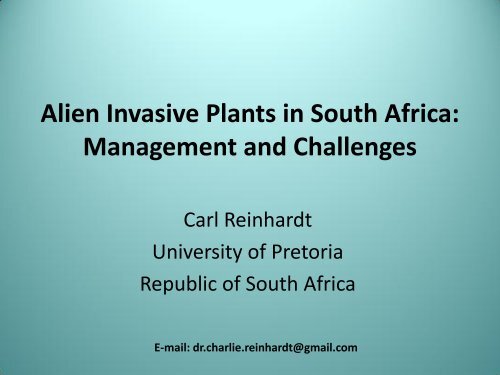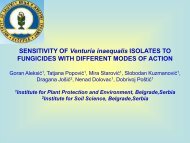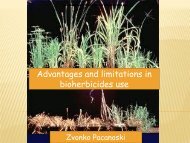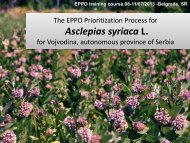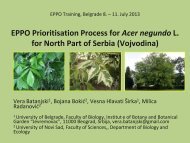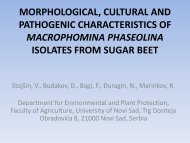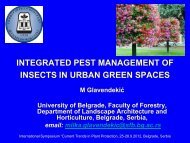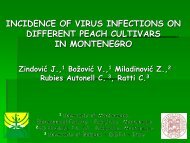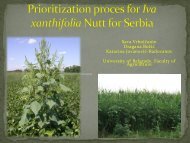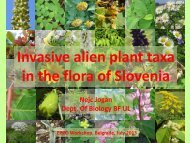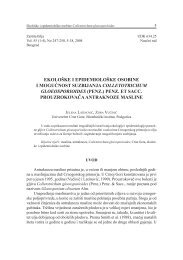Alien Invasive Plants in South Africa Management and Challenges
Alien Invasive Plants in South Africa: Management and ... - Izbis
Alien Invasive Plants in South Africa: Management and ... - Izbis
You also want an ePaper? Increase the reach of your titles
YUMPU automatically turns print PDFs into web optimized ePapers that Google loves.
<strong>Alien</strong> <strong>Invasive</strong> <strong>Plants</strong> <strong>in</strong> <strong>South</strong> <strong>Africa</strong>:<br />
<strong>Management</strong> <strong>and</strong> <strong>Challenges</strong><br />
Carl Re<strong>in</strong>hardt<br />
University of Pretoria<br />
Republic of <strong>South</strong> <strong>Africa</strong><br />
E-mail: dr.charlie.re<strong>in</strong>hardt@gmail.com
<strong>Africa</strong> <strong>in</strong> relation to Europe
Contrast between small <strong>and</strong> commercial scale farm<strong>in</strong>g <strong>in</strong> <strong>Africa</strong> is large
Maize <strong>and</strong> cassava are staple crops,<br />
here with peanuts as <strong>in</strong>tercrop to<br />
contribute nitrogen.<br />
Subsistence farm<strong>in</strong>g is a way of life<br />
for the majority of <strong>Africa</strong>ns liv<strong>in</strong>g <strong>in</strong><br />
rural areas.
Many projects <strong>in</strong> <strong>Africa</strong> fail due to lack of appropriate knowledge ‒<br />
result<strong>in</strong>g <strong>in</strong> disturbance of ecosystems<br />
Failed biodiesel project <strong>in</strong> Mozambique<br />
– Jatropha curcas on 10,000 ha
<strong>South</strong> <strong>Africa</strong> is for the greater part a water-stressed country.<br />
Most regions receive
Disturbance of natural habitats:<br />
• Fire is a natural factor which is<br />
exploited by humans for vegetation<br />
management<br />
• Mechanical clear<strong>in</strong>g of<br />
vegetation is most destructive ‒<br />
creates space for alien <strong>in</strong>vasive<br />
plants
Indigenous species can<br />
“densify” <strong>and</strong> dom<strong>in</strong>ate due<br />
to disturbance of vegetation –<br />
<strong>in</strong> this case due to overgraz<strong>in</strong>g<br />
Stoebe spp<br />
Asparagus spp
<strong>South</strong> America orig<strong>in</strong>: Opuntia ficus-<strong>in</strong>dica<br />
Biocontrol with <strong>in</strong>sect,<br />
Dactylopius opuntiae
Examples of alien species deliberately planted for shelter,<br />
fuel (firewood), build<strong>in</strong>g material<br />
Populus canescens<br />
Eucalyptus spp
European orig<strong>in</strong>: Populus canescens<br />
Typically <strong>in</strong>vades wet habitats
Campulocl<strong>in</strong>ium macrocephalum ‒<br />
imported for horticulture, but devastat<strong>in</strong>g<br />
to grassl<strong>and</strong><br />
Orig<strong>in</strong>: <strong>South</strong> America
Conyza spp on fallow crop fields
Solanum elaeagnifolium <strong>in</strong> Roundup Ready® maize
<strong>Alien</strong> <strong>Invasive</strong> <strong>Plants</strong> <strong>in</strong> the Kruger National Park, <strong>South</strong> <strong>Africa</strong><br />
<strong>Alien</strong> <strong>in</strong>vasive plants represent a<br />
serious threat to natural biodiversity <strong>in</strong><br />
this conservation area of 20,000 km 2 .<br />
More than 350 alien plants occur<br />
<strong>in</strong> KNP, of which about 30 are<br />
highly <strong>in</strong>vasive.
Parthenium hysterophorus (Asteraceae) ‒ annual/biannual; herbaceous<br />
A recent <strong>in</strong>vader whose<br />
spread is promoted by<br />
humans <strong>and</strong> natural forces
Parthenium preferentially <strong>in</strong>vades<br />
disturbed areas.
Field trial: Interference potential of P. hysterophorus with <strong>in</strong>digenous<br />
grass species <strong>in</strong> the KNP
Parthenium plants on 18 Jan 2004
10 Feb 2004<br />
One meter<br />
height<br />
<strong>in</strong>crease <strong>in</strong><br />
3 weeks!
Lettuce grown together with Parthenium plants <strong>in</strong> hydroponic solution<br />
Control 2 Parthenium 4 Parthenium
Parthen<strong>in</strong> content <strong>in</strong> various parts of P. hysterophorus<br />
Parthen<strong>in</strong><br />
mg/g<br />
16<br />
14<br />
12<br />
10<br />
8<br />
6<br />
4<br />
2<br />
0<br />
14.5<br />
4.5<br />
3.7<br />
1.1<br />
0.17 0.1<br />
root stem leaf flower fruit pollen
-----------<br />
---- dip ----<br />
-----------<br />
-----------<br />
homogenisate<br />
-----------<br />
Parthen<strong>in</strong> [mg/g]<br />
Parthen<strong>in</strong> <strong>in</strong> TBME leaf-dips, <strong>and</strong> <strong>in</strong> leaf-homogenates after dipp<strong>in</strong>g<br />
14<br />
12<br />
10<br />
8<br />
6<br />
4<br />
2<br />
0<br />
In TBME (organic solvent)<br />
13.4<br />
11.2<br />
12.0<br />
1.4<br />
In leaves post-TBME<br />
1.2 1.0<br />
Old Intermediate Young<br />
Old Intermediate Young<br />
Leaves of different age<br />
Leaves of different age<br />
•REINHARDT, C.F., VAN DER LAAN, M., BELZ, R.G., HURLE, K. & FOXCROFT, L., 2006. Production dynamics of the<br />
allelochemical parthen<strong>in</strong> <strong>in</strong> leaves of Parthenium hysterophorus L. J. Plant Diseases <strong>and</strong> Protection 20, 427-433.<br />
•BELZ, R.G., REINHARDT, C.F., <strong>in</strong>termediate<br />
FOXCROFT L.C. & HURLE, K., 2007. Residue allelopathy <strong>in</strong>termediate<br />
Parthenium hysterophorus L. –<br />
Does parthen<strong>in</strong> play a lead<strong>in</strong>g role? Crop Protection 26, 237-245.<br />
•VAN DER LAAN, M., REINHARDT, C.F., BELZ, R.G., TRUTER, W.F., FOXCROFT, L.C. & HURLE, K., 2008. Interference<br />
potential of the perennial grasses Eragrostis curvula, Panicum maximum <strong>and</strong> Digitaria eriantha with Parthenium<br />
hysterophorus. Tropical Grassl<strong>and</strong>s 42, 88-95.<br />
old leaf leaf juvenile<br />
leaf<br />
old leaf leaf juvenile<br />
leaf
<strong>Management</strong> of alien <strong>in</strong>vasive plant species<br />
• Ma<strong>in</strong>ta<strong>in</strong><strong>in</strong>g natural biodiversity is key ‒<br />
disturbance/degradation directly or <strong>in</strong>directly by humans is a<br />
major destroyer of diversity.<br />
• Chemical control (herbicides) has limitations <strong>in</strong> natural<br />
ecosystems: non-selectivity; environmental contam<strong>in</strong>ation.<br />
• Biocontrol us<strong>in</strong>g natural enemies are highly selective <strong>and</strong><br />
takes a long time to be effective.
Before biocontrol<br />
Aquatic alien <strong>in</strong>vader Pistia<br />
stratiotes <strong>in</strong> Sunset Dam, KNP<br />
Insect biocontrol agent<br />
After biocontrol
Special thanks to THE TEAM


